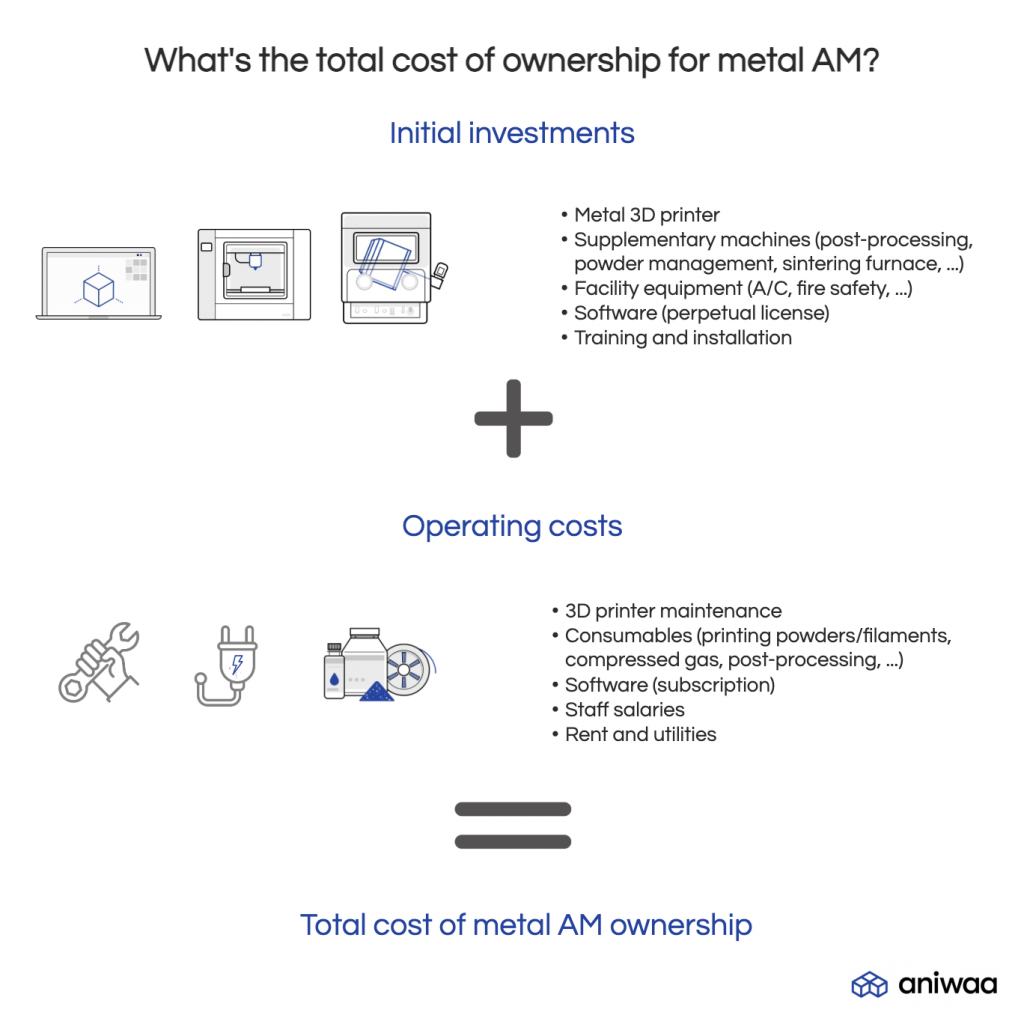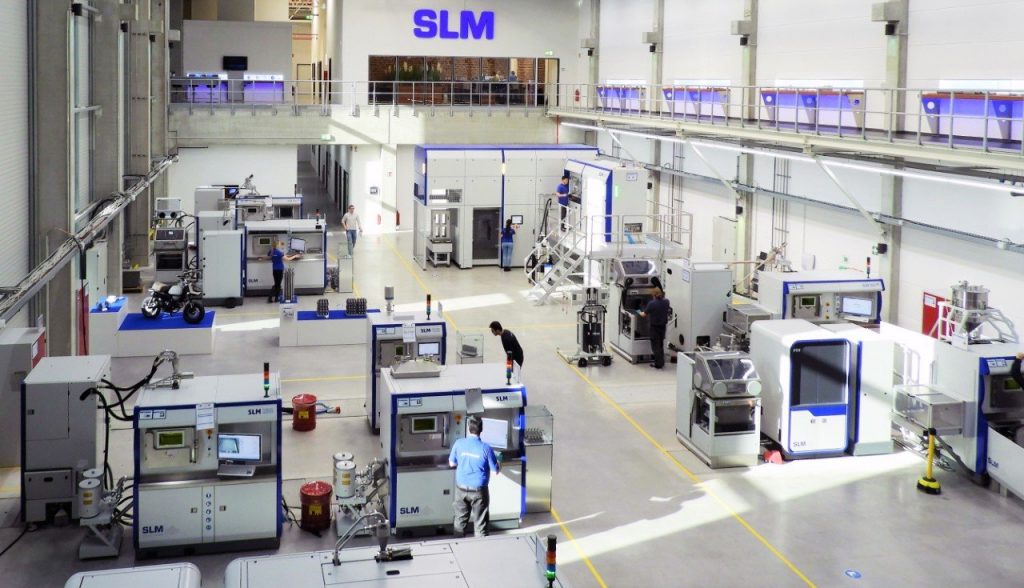What’s the total cost of ownership for metal 3D printing?
The cost of metal 3D printing
One of the principal advantages of metal additive manufacturing is its ability to simplify production. Parts that were previously made using two or three manufacturing techniques can now be made with just one, and in less time.
But although metal 3D printers can function as standalone production systems, they still carry with them a host of associated processes and, more importantly, costs. Many of these metal 3D printing costs are hard to quantify accurately in advance; others are so hidden they might be forgotten about entirely.
This article looks at the outgoings associated with metal 3D printing, including hardware, software, materials, and other necessary costs, helping businesses decide whether they can afford metal additive manufacturing.

Metal 3D printers
The highest upfront cost of metal additive manufacturing is the metal 3D printer itself. The investment in the hardware might pay off quickly, but it still represents a significant outlay and a high barrier to entry.
The price of a metal 3D printer varies depending on factors like technology, quality, size, and features. At the low end, prices generally start at around $50,000, but plenty of production-ready powder systems cost well over $500,000. The largest and most expensive metal 3D printers are priced in the millions.
Metal filament extrusion is the cheapest technology, with machine prices often under $150,000. Material jetting and binder jetting systems cost upward of $100,000, while most directed energy deposition printers cost upward of $500,000 (though a select few under $100,000 do exist). Powder bed fusion (PBF) is the dominant metal AM family; SLS and DMLS printers can cost millions of dollars, but the ubiquity of the technology has also led to more affordable systems below $150,000.
As a rule of thumb, end-to-end metal 3D printing systems will cost at least $100,000, but often cost over $250,000.
The prices mentioned in this article are ballpark figures and estimates. Please contact us to obtain precise quotes for your project.
Materials
Like metal 3D printers, metal 3D printing materials vary in price. Metal 3D printing powders are typically far more expensive than other material forms like wire, bars, and pellets, since the powders must be free of defects and particle sizes must be uniform. Aluminum and stainless steel powders can cost over $100/kg, while titanium (used in industries like aerospace and medical) can cost over $300/kg.

But raw metal feedstock is not the only material cost in metal AM. PBF systems may require argon or nitrogen gas to create an inert atmosphere, potentially costing thousands or tens of thousands of dollars per year, while non-PBF processes may require other materials: binder jetting systems, for example, require a separate polymer binder to build metal parts.
In addition to material costs, metal AM adopters may need to invest in powder management and handling equipment, and special, industrial-grade vacuum cleaners.
Software
Companies may require several different types of AM-specific software in order to 3D print metal parts. Examples include CAD, DfAM (design for additive manufacturing), print preparation, and print simulation software, in addition to AM workflow tools like manufacturing execution systems (MES).
Individual software subscriptions can each cost thousands of dollars per year, with industry-focused tools like topology optimization and workflow automation being especially costly.
At present, subscriptions are a more common payment model than upfront perpetual licenses. This may be beneficial for newcomers, since many other capital investments — machinery, for example — are required.
Post-processing
The post-processing of metal 3D printed parts may require additional machinery such as de-powdering machines and furnaces for heat treatment, in addition to surface finishing equipment (for processes like bead blasting and polishing), potentially adding tens or hundreds of thousands in investment costs.
Some AM hardware suppliers sell their metal 3D printers bundled with, for example, de-binding and sintering stations, while others do not.
As well as upfront equipment costs, running costs will be incurred by products (like chemicals and blast media) and labor-intensive processes (like support removal).

Facility equipment
Some of the hidden costs of metal additive manufacturing relate to the manufacturing environment required for 3D metal printing.
Even when a company has found adequate floor space for its new AM system, it may require additional equipment such as an air conditioner, a humidifier or dehumidifier, and fire safety equipment necessitated by the storage of flammable powders. It may even be necessary to reinforce the factory floor due to the several-ton weight of some AM systems.

Some 3D printers, such as the Desktop Metal Studio 2 (Bound Metal Deposition) and the ExOne Metal Designlab (water-based metal paste extrusion), do not use compressed gases and can theoretically be used in office environments, reducing facility costs and requiring less space planning.
Other costs
Further metal additive manufacturing costs include 3D printer maintenance, which can cost tens of thousands of dollars per year, and staff costs such as salaries and training. Expertise in additive manufacturing remains scarce, so engineers and operators can command relatively high wages. Additionally, in many cases, operators will require protective equipment, too (gloves, bodysuits, eyewear, face masks, …).
Facility costs such as rent and energy must also be considered, as they can reach thousands of dollars a year.
| Initial investments | Operating costs |
|---|---|
| Metal 3D printer(s) | 3D printer maintenance |
| Supplementary machines (post-processing, powder management, sintering furnace, …) | Consumables (printing powders/filaments, compressed gas, post-processing, …) |
| Facility equipment (air conditioners, dehumidifiers, fire safety equipment) | Rent and other utilities |
| Software (perpetual license) | Software (subscription) |
| Training and installation | Staff salaries |
Does metal 3D printing justify the cost?
Due to these steep entry barriers, many companies choose to outsource their metal additive manufacturing needs, relying on metal 3D printing service providers who already own and master the entire production chain.
Indeed, the total cost of ownership for 3D metal printing can be high, with significant upfront expenses and ongoing operating costs. Whether it’s worth it or not all depends on how much money a company expects to make (or save) through metal AM.
If the company can establish a customer base in a high-value industry like aerospace or medical (where part certification is essential), or if it can carry out in-house rapid prototyping to reduce dependence on third parties, the costs of 3D printing can ultimately be dwarfed by the savings.
 English
English  Français
Français

